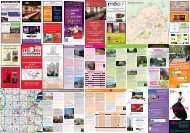The Galerie du Temps at the Louvre-Lens A unique presentation of ...
The Galerie du Temps at the Louvre-Lens A unique presentation of ...
The Galerie du Temps at the Louvre-Lens A unique presentation of ...
Create successful ePaper yourself
Turn your PDF publications into a flip-book with our unique Google optimized e-Paper software.
Assyrian Empire<br />
3. <strong>The</strong> Assyrian demon Pazuzu<br />
Beginning <strong>of</strong> <strong>the</strong> 1 st millenium BC, bronze.<br />
H. 15 cm. ; W. 8.60 cm. ; D. 5.60 cm.<br />
Musée <strong>du</strong> <strong>Louvre</strong>, Department <strong>of</strong> Near Eastern Antiquities, MNB 467<br />
© 2007 Musée <strong>du</strong> <strong>Louvre</strong> / Thierry Ollivier<br />
Term <strong>of</strong> loan for display <strong>at</strong> <strong>the</strong> <strong>Louvre</strong> - <strong>Lens</strong> : 1 year<br />
Pazuzu was one <strong>of</strong> <strong>the</strong> demon-gods <strong>of</strong> <strong>the</strong> underworld, although<br />
he was sometimes invoked to beneficial ends. This bronze<br />
st<strong>at</strong>uette is one <strong>of</strong> <strong>the</strong> finest represent<strong>at</strong>ions <strong>of</strong> <strong>the</strong> figure. <strong>The</strong><br />
inscription covering <strong>the</strong> back <strong>of</strong> <strong>the</strong> wings describes <strong>the</strong> demon's<br />
personality: "I am Pazuzu, son <strong>of</strong> Hanpa, king <strong>of</strong> <strong>the</strong> evil spirits <strong>of</strong> <strong>the</strong><br />
air which issues violently from mountains, causing much havoc."<br />
A hybrid mythological being<br />
Pazuzu first appeared in <strong>the</strong> 1st millennium BC in hybrid form, with <strong>the</strong> body <strong>of</strong> a man and <strong>the</strong> head <strong>of</strong> a<br />
scowling dragon-snake which also has both canine and feline fe<strong>at</strong>ures. He is represented as a spirit with two<br />
pairs <strong>of</strong> wings and talons like those <strong>of</strong> birds <strong>of</strong> prey. He also has a scorpion's tail and his body is usually<br />
depicted covered in scales.<br />
A spirit invoked for protection<br />
<strong>The</strong> inscription on <strong>the</strong> back <strong>of</strong> <strong>the</strong> wings describes <strong>the</strong> figure's personality: "I am Pazuzu, son <strong>of</strong> Hanpa, king <strong>of</strong><br />
<strong>the</strong> evil spirits <strong>of</strong> <strong>the</strong> air which issues violently from mountains, causing much havoc." <strong>The</strong> demon Pazuzu was<br />
associ<strong>at</strong>ed with ill winds, particularly <strong>the</strong> west wind which brought <strong>the</strong> plague. His terrifying, scowling face and<br />
his scaly body repel <strong>the</strong> forces <strong>of</strong> evil, which meant th<strong>at</strong> in certain circumstances <strong>the</strong> figure was considered a<br />
protective spirit. Pazuzu, a demon from <strong>the</strong> hellish underworld, had <strong>the</strong> power <strong>of</strong> repelling o<strong>the</strong>r demons, and<br />
was thus invoked for beneficial ends, particularly to drive his wife Lamashtu back to <strong>the</strong> underworld. Lamashtu<br />
was a demoness who <strong>at</strong>tacked men to infect <strong>the</strong>m with various diseases.<br />
A popular image <strong>du</strong>ring <strong>the</strong> Assyrian period<br />
Pazuzu was widely depicted in Assyrian art <strong>of</strong> <strong>the</strong> 1st millennium BC in <strong>the</strong> form <strong>of</strong> numerous bronze st<strong>at</strong>uettes<br />
and protective amulets, made in a variety <strong>of</strong> m<strong>at</strong>erials ranging from plain terracotta to precious ste<strong>at</strong>ite or jasper.<br />
During this period, many beliefs and magical practises were associ<strong>at</strong>ed with Pazuzu. <strong>The</strong> ring <strong>at</strong> <strong>the</strong> top <strong>of</strong> <strong>the</strong><br />
st<strong>at</strong>uette suggests th<strong>at</strong> this type <strong>of</strong> object was worn round <strong>the</strong> neck or hung up in <strong>the</strong> home, particularly where<br />
invalids were sleeping. O<strong>the</strong>r examples <strong>of</strong> demon-gods <strong>of</strong> <strong>the</strong> underworld, including Bes and Humbaba, are also<br />
<strong>at</strong>tested in <strong>the</strong> Orient <strong>of</strong> antiquity.<br />
3



